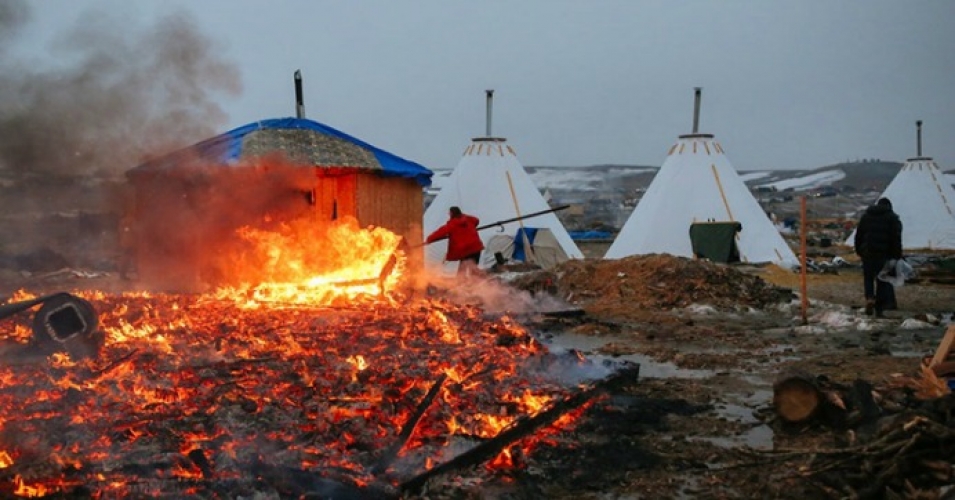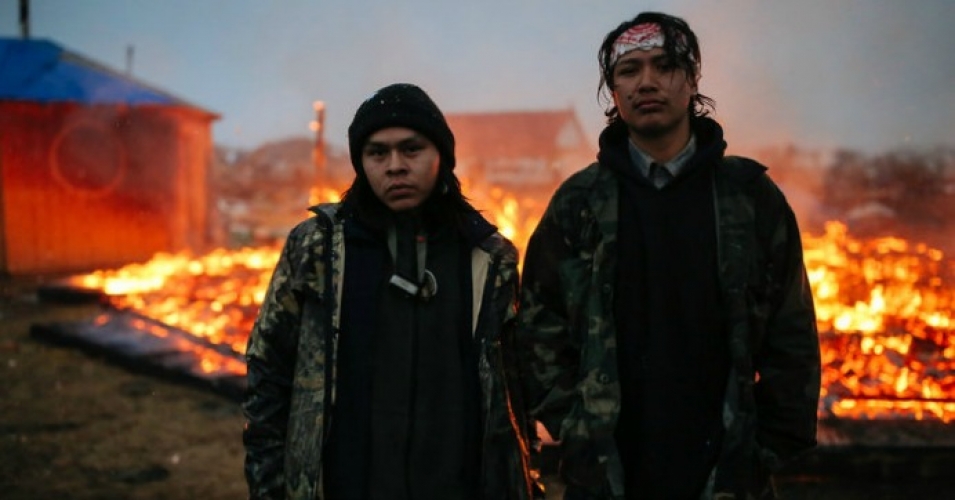
This is a story of victory for the earth and of the end of the Keystone XL pipeline. It also involves the Dakota Access pipeline and the Standing Rock Lakota reservation, indeed the entire world, all of which is threatened by our desperate last burst of fossil fuel exploitation. It is a story of what the dogged persistence and creativity of indigenous people and their allies can do against the kind of power we’ve been told is impossible to resist. But it’s a story without a guaranteed ending. The ending depends on us.
In 2004, small indigenous nations living near the Alberta Tar Sands project, the largest unconventional oil extraction effort in the world, began reaching out for help. Not only was the project interfering with their water, fishing, and hunting infrastructure, but rare and unusual cancers were appearing. They contacted policy experts at the National Resources Defense Council (NRDC) in Washington, D.C., who met with them in 2005 and saw photographic documentation of the devastation. These experts began to gather data and to raise awareness in the United States, on whose special refineries the project relied. Experts focused on the unique risks posed by tar sands at every stage of production, including extraction, transportation, and refinement. It wasn’t enough, but without the testimony and photographs supplied by indigenous people, experts would not have noticed for some time.
In 2008, approximately two dozen people from indigenous nations and environmental activist groups met to develop an overall strategy. The groups decided that the most promising activist target was the Keystone XL (KXL) pipeline, proposed by the giant TransCanada (now TC Energy) corporation to move the tar sands to refineries on the Texas Gulf Coast. Stopping the pipeline would rob the Tar Sands project of financial justification. The unusually expensive techniques required for extracting, transporting, and refining tar sands made them unusable when the global barrel price was low, and any increases in the cost of production would make investors flee.
This small group of people had almost no support. Going up against the Keystone XL pipeline meant taking on the Republican Party, half the Democratic Party, the U.S. government, the Canadian government, and the entire oil industry. But with the presence of indigenous organizers in this group, they soon discovered they had something far more important.
Attendees at the meeting began spreading the word. Clayton Thomas-Muller, a climate activist belonging to the Columb Cree Nation of Manitoba and an attendee, noticed that the pipeline would be running through the Oglala aquifer, a route that, in addition to being an environmental scourge, also threatened indigenous sovereignty. He began using his existing connections from previous anti-pipeline campaigns in indigenous nations to persuade tribal councils to pass resolutions opposing KXL, which they took directly to President Obama in 2011. He continued to work on tribal organizing throughout the effort to stop KXL. By 2010, Jane Kleeb of Bold Nebraska became aware of the Keystone XL threat. She attended the first State Department hearing on the pipeline in York, Nebraska in May out of curiosity without even knowing what tar sands were. At the hearing, she noticed that over 100 farmers and ranchers spoke out individually against the pipeline project and the only person speaking for it represented a union of construction workers on the pipeline. Kleeb thought the pipeline could be stopped if she could persuade Nebraska’s increasingly resistant farmers and ranchers to join indigenous people and environmentalists. To do this, she relied on indigenous support, including Muller’s. As a result, 150 tribes from the United States and Canada met in her state to sign an agreement opposing pipeline construction. The indigenous people she worked with also gave her good organizing and spiritual advice. First, stay rooted in real, concrete stories, not abstract principles. Second, never give up. The latter was remarkable guidance, especially coming from people who have endured what indigenous people in North America have endured.
The pipeline rose to national awareness in 2011, when former NASA climate scientist James Hansen wrote an essay arguing that it would be “game over for the climate” if the Alberta tar sands were fully developed. After this, 350.0rg got involved. They arranged for scores of celebrities to engage in civil disobedience in front of the White House. Here in Texas, Cindy Spoon, a graduate student at the University of North Texas, co-founded the Tar Sands Blockade after the White House protests and, following Kleeb’s lead, began organizing local pipeline resistance in communities along the Texas portion of the planned route. The Tar Sands Blockade, and the Great Plains Tar Sands Resistance that grew out of it, used bold, theatrical, and courageous tactics to block construction of the pipeline. Cindy also followed the guidance Kleeb had received from indigenous people in Nebraska, to stay rooted in stories and never give up. Tar Sands Blockade kept the issue in the news in Texas and Oklahoma, and occasionally in the national news, long after President Obama had already approved construction of the southern half. And we cost TC Energy a lot of money.
Cindy Spoon personally recruited a friend of mine and fellow activist for an arrest-risking direct action effort. I attended a training camp she organized and eventually got myself arrested at a KXL pumping station under construction in Seminole County, Oklahoma. Indigenous people were crucial agents in this experience. I and my colleague were thrown into what turned out to be the “Indian tank” at the county jail. The local Seminole men in jail with us that day were neither surprised to hear about the utterly unprincipled way power works in the United States, nor surprised to find us to be relatively naïve about it. But the men who spoke most freely with us also insisted on another kind of power. One guy wanted to form a circle and have each of us read something from the Bible that meant something to us and explain what it meant. During one of his turns, he quoted a verse from Matthew 19 about all things being possible with God. He looked at us and said, “this means you keep going, no matter what.” Stay rooted in real stories, and never give up.
For years after the intense efforts of 2011 and 2012, the fight against the KXL remained precarious. President Obama temporarily delayed it, but Trump attempted to accelerate it. Indigenous groups continued to resist, leading efforts against the northern half of the pipeline. And then indigenous people broadened the fight, linking it to the Dakota Pipeline resistance on the Standing Rock reservation, where the effort took on a more explicit indigenous spiritual context. In the morning, Lakota women walked to Cannonball River for a water ceremony. At dawn, local people chanted in the Lakota language. At night, Lakota elders tended a sacred fire, saying “Water is life. Defend the sacred.” In December 2016, Chief Arvol Looking Horse, 19th keeper of the Sacred White Buffalo Calf Pipe and Bundle, visited the camp where his son was a leader. Reminding those present of the millions of attacks on the integrity of the earth community, he insisted that power lies in the common indigenous commitment to the sacredness of the physical world. He gave the same guidance Jane Kleeb had received from indigenous activists. Our struggle, he said, must be tireless and “prayer-filled,” rooted in stories drawn from experience, and we must never give up. He reassured them they would be victorious because, though people may believe this isn’t their fight, “Standing Rock is everywhere.” This sentence was, I have heard from friends who were present, the missing piece of the puzzle, exposing the unreality of indifference. Yes. It is everywhere. Nowhere on earth is safe from this threat, and we are all in the midst of it.
In January 2021, President Biden signed an executive order revoking the permit for the last phase of the KXL pipeline. By this time, investors had already been fleeing. The efforts of Clayton Thomas-Muller, Jane Kleeb, Cindy Spoon and indigenous activists across the pipeline route were bearing fruit. On June 9, TC Energy (TransCanada) abandoned the project. With the Keystone XL dead, the Alberta Tar Sands is likely to follow.
The Dakota Access pipeline, however, remains active. The sacred water on which the people of Standing Rock depend remains threatened. We can celebrate a genuine victory with the end of the KXL and it is appropriate to be grateful for the indigenous guidance responsible for this victory. Nevertheless, the struggle continues and it is our struggle, not just someone else’s. We may be afraid to feel ourselves in the midst of it, but we are. The guidance remains true:
Stay rooted in real stories. Never give up. Standing Rock is everywhere.
Alan Jay Richard, Ph.D., is a scholar and activist currently affiliated with Realistic Living, an educational nonprofit in rural north Texas that researches and experiments with new forms of collective religious practice. His current research and writing is focused on ekklesia, valuation, and frontier between religion and politics.
Originally published by Resilience.org

















































